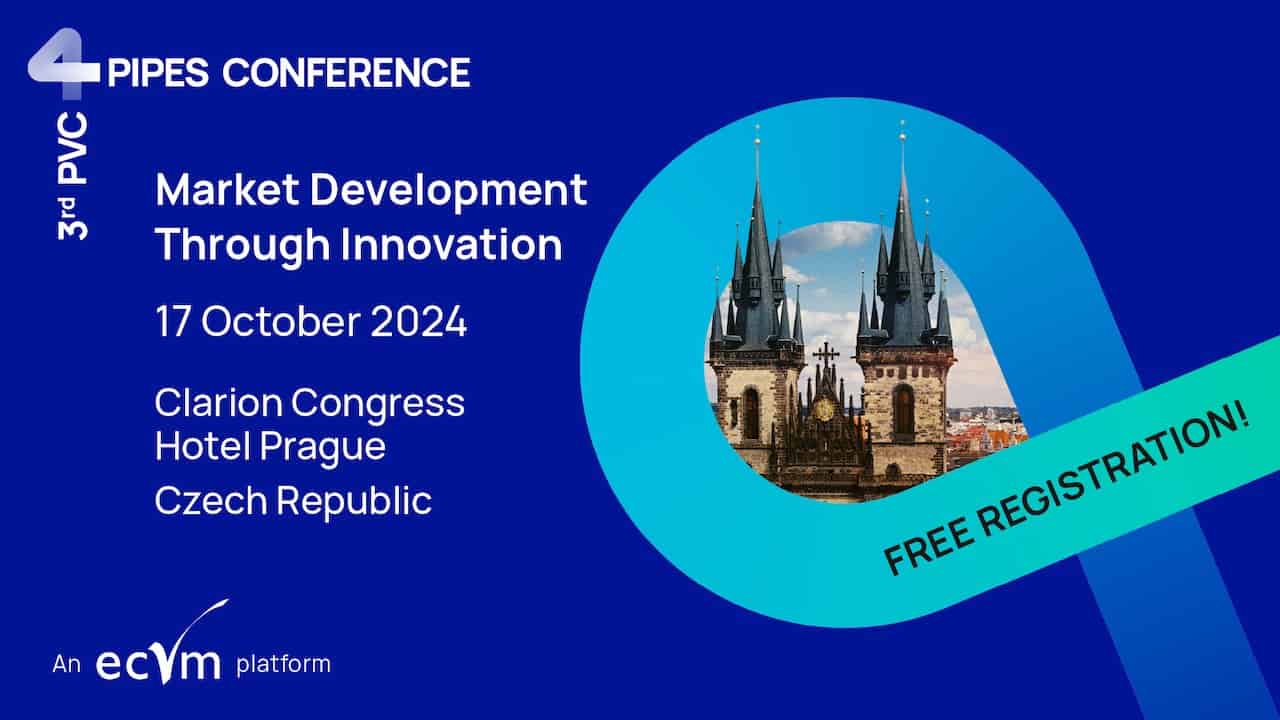
Market Development Through Innovation
The next edition of the ECVM Value Chain Platform Conferences will take place in Prague, Czech Republic. Over the course of two days, participants will have the opportunity to engage in the 4th PVC4Cables Conference and the 3rd PVC4Pipes Conference.
Addressing the common theme Market Development Through Innovation both conferences are open to all actors of the PVC cable and PVC pipe industries. They aim to present and discuss trends and opportunities in both sectors, with a particular focus on sustainability and innovation.
Programme headlines
The one-day PVC4Pipes event of 17 October will focus on the following themes:
- European PVC pipes market update
- Regulatory challenges and opportunities for PVC pipes and additives
- Addressing sustainability challenges with PVC pipe networks
- European standardisation developments promoting the recycling of PVC pipe systems
- Readiness of PVC pipes for the hydrogen economy
- Sustainable innovations along the PVC pipes value chain
PVC4Pipes and PVC4Cables are looking forward to welcoming you in Prague, Czech Republic, at the Clarion Congress Hotel, on 16 and 17 October 2024.
Registration is free of charge!
Discover the speakers and abstracts – more to come!

Global Developments for PVC Pipe Applications in the Light of Upcoming Restrictions
Stefan Fokken, Head of Research and Development, Baerlocher
Abstract
Pipe applications based on PVC resin are already a mature and well known application field. Nonetheless globally it remains an area of constant development and technical improvement which nowadays lead to more widespreading use of orientated PVC pies (O-PVC) and the increased use of C-PVC pipes e.g. in India for hot water supply installations. In itself these two applications do not required a systematic change in known stabilization systems but just processing specific adjustment e.g of rheology.
Depending on regional preferences these applications might be stabilized using tin based stabilisers. Keeping in mind the regulatory pressure on tin stabilisers in Europe which is expected to increase after the ECHA assessment of PVC and its additives and which is also expected spreading out of our local legislation to other regions this clearly indicates a need for Ca-based stabilisers for these applications.
Based on these triggers Baerlocher in cooperation with the leading providers of O-PVC technology has developed Ca-based stabilisers to be used in O-PVC pipe extrusion. Specifically for the India market we have developed Super-pack solutions for C-PVC processing which contain all additives besides neat C-PVC resin. Insights in these developments will be shared in the presentation.
Beyond these concrete examples of new developments we will shed some light on the implications that arise from the ECHA assessment of PVC and its additives which goes beyond the already known pressure on tin based stabiliser ingredients.

Volatile Organic Compounds (VOC) Reduction in Solvent Cement
Rajesh Ranjan, Director of Research and Development, Weld-On Adhesives
Abstract
The presence of volatile organic compounds (VOC) containing materials in solvent cement is essential to perform its primary function of joining PVC pipes and fittings. However, the use of solvent cements releases VOCs, which cause smog and contribute to air pollution. This has led agencies such as Southern California’s South Coast Air Quality Management District (SCAQMD) to develop and establish VOC guidelines to improve air quality for the environment.
The source of VOCs in solvent cement is the different type of solvents used to help soften the surface of PVC pipes and fittings in preparation for the welding process. VOC evaporation mainly occurs during the solvent welding process when the applied layer of solvent cement is exposed to air.
Not all VOCs are created equal and their impact on the environment depends on several variables such as unique chemical reactivity and volatility. For instance, some VOCs form ground-level ozone at a much slower rate and are considered minimally reactive compared to VOCs that react at a much faster rate. This provides an opportunity for solvent cement manufacturers to develop environment friendly products that have reduced emissions of the most reactive VOCs while ensuring product stability and performance standards required by the market.

Thermoforming Processes for Sockets Integrated in OPVC Pipes for Pressurized Water Distribution
Marco Secchiari, Technical Manager, Sica SpA
Abstract
In plastic pipes for distribution of pressurized water, the socket jointing technique made with the Rieber system is mainly used in PVC-U pipes. Recently, a new thermoforming process has been developed that allows the Rieber system socketing of PVCO pipes for the distribution of pressurized water. The procedure is then applicable to all PVCO pipes of different operating pressure classes and to all PVCO pipes of different orientation level of the material.
Specifically, it is applicable to ISO 16422 piping systems for pipes with nominal diameters from DN/OD 63 mm up to DN/OD 630 mm; to AS/NZS 4441 piping systems for pipes with nominal diameters from DN 100 up to DN 450 and to ANSI/AWWA C909 piping systems for pipes with nominal diameters from DN/OD 4” up to DN/ OD 24”.
The procedure can be applied both to PVCO pipes with orientation obtained by inflation in a tank and to PVCO pipes made and oriented directly in the extrusion line. Special characteristics of the heated Rieber socket forming process are the physical phenomena of PVCO pipe and of the sealing gasket, which are considerably different from those that result in PVC-U pipe. Controlling these phenomena required the development of unconventional but absolutely effective technological solutions.
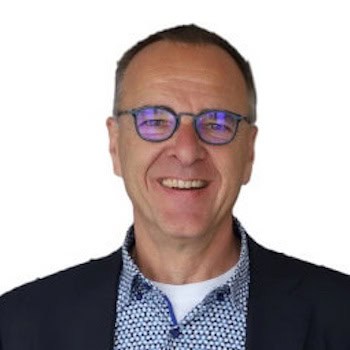
A Solution for PVC Pipe Waste Legacy Additives Extraction
Eric Romers, Head of Project Circle, Sustainability Business, INEOS Inovyn
Abstract
At INEOS Inovyn, our mission is to make all PVC waste fully recyclable, with the ambitious target of having our first industrial unit operational by 2030. To advance this goal, we have launched two pilot plants in Jemeppe-sur-Sambre, Belgium, home to our main R&D center.
These pilot plants build on the industrial experience gained from Vinyloop™ technology, which was in use in Ferrara (I) from 2002 to 2018, and are specifically designed to enhance PVC dissolution technology. This technology is crucial for recycling complex PVC waste, including composites and materials containing legacy additives. The pilot plants are currently validating lab test results, confirming the successful extraction of stabilizers and plasticizers while ensuring compliance with REACH regulations.

Towards an Exit Assessment Program for PVC Drinking Water Pipes: Added Value of a Failure Registration Database
Amitosh Dash, Scientific Researcher, Water Infrastructure, KWR – Water Research Institute
Abstract
An asset manager at a drinking water utility has several responsibilities surrounding the buried drinking water supply assets. The majority of these assets in the Netherlands is composed of PVC, installed across various timespans. A topical issue is related to the replacement of PVC pipes installed several decades ago. Not only are these pipes “older”, but these pipes belong to an era where PVC pipe production was still in its maturation phase. As a consequence, the erstwhile commissioned pipes show a greater variation in material quality, ranging from bad to good. This variation in quality poses a major challenge for asset managers in prioritizing the “older” PVC pipe groups for replacement.
To tackle this challenge, KWR is collaborating with drinking water utilities, research organizations, material testing laboratories, and universities in setting up a multi-year exit assessment program. This exit assessment program will comprise of exhuming pipe segments and subjecting them to an array of tests – few established, few under development. Since pipe exhumation and subsequent laboratory testing is a costly endeavor, pipe selection needs to be strategic. This strategic selection will be facilitated with USTORE, a database wherein multiple Dutch water utilities regularly register pipe failures. Since its inception in 2009, more than 35000 failures have been registered offering a rich database.
The presentation will give a birds-eye view of the exit assessment program and the role of USTORE in it. Institutions interested in collaborating/contributing to the upcoming multi-year exit assessment program are warmly welcome to get in contact with KWR.

Standardisation, a Catalyst for Recycling PVC in Piping Systems
Roland Dewitt, Manager, ACCIPIS
Abstract
Imagine standardisation as a tool for market development or even innovation despite standards are often perceived as filters or obstacles that force stakeholders to strictly specify products according to their intended use.
In the field of construction and the use of recycled materials, the normative framework is traditionally very prescriptive. However, recent developments show that there is a real desire to evolve in order to meet the challenges arising from the very principle of the circular economy: it is a question of both opening up markets for recycled materials in a responsible approach, but also of designing articles and systems that can be recovered at the end of their life, in particular through material recycling, and whose safety remains guaranteed.
The normative work is not simple because there are many gaps to fill as many opportunities to seize: e.g. the extension of the virgin materials designation system to recycled plastics, the characterisation of recyclates, the assessment of their quality, their conformity regarding their use, the assessment of products containing recycled materials, the dedicated terminology.
Several technical committees of ISO, CEN and CENELEC are working on these subjects and the momentum has accelerated since the M/584 Standardisation Request on plastics recycling and recycled plastics given by the EC to the European standardization committees.
Although the mandated program should be finalised in August 2025, we thought it would be interesting to present an update focusing on PVC, less than a year before the deadline.
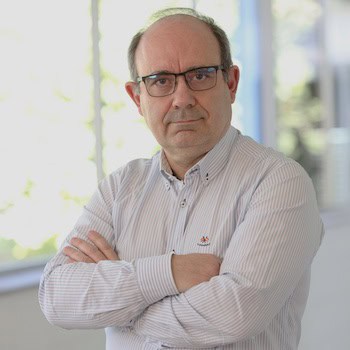
Securing a 100+ Year Design Lifetime for PVC-U Pressure Pipes
Joaquin Lahoz Castillo, Plastic Pipes Specialist, CEIS
Abstract
To generate public data demonstrating that PVC-U pressure pipes can be serviced for 100+ years, an investigation project has been launched in 2020 by CEIS and PVC4Pipes to clarify the relationships between processing temperatures and design lifetime of PVC-U pipes.
Ca/Zn stabilized pressure pipes were extruded with different processing temperatures and characterized by their DSC onset temperature, DSC gelation degree and resistance to dichloromethane. Their long-term hydrostatic strength was predicted using the methods described in ISO 9080. The desired outcome of this project was to set up a correlation between extrusion temperature and Lower Prediction Level of the stress that a PVC-U pipe can withstand after 100 years (LPL100y).
The results of this study show that an extrusion temperature of 180ºC is enough to achieve MRS250 classification. A moderate increase (+5ºC/10ºC) of extrusion temperature leads to a smooth decrease in the slope of regression curve at 20ºC and, therefore, to an increase of predicted LPL100y values. Higher processing temperatures (≥195ºC) result in marginal increases in LPL100y, with clear risk of material degradation while processing.
The increase of LPL100y allows the MRS250 classification to be extended up to 100+ years with the benefit for prescribers and designers to design their water networks for 100+ years using the design stress and design coefficient values typically used for a design lifetime of 50 years.
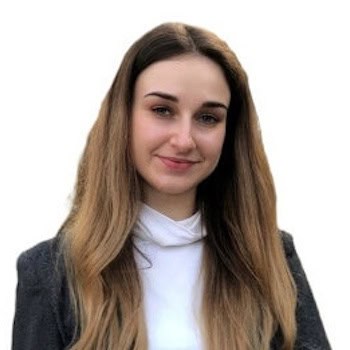
Challenges and Market Dynamics in Central Europe's PVC Pipes Industry: From Raw Materials to Construction Sector
Elizaveta Harkusha, Lead Market Analyst, Chem-Courier
Abstract
The PVC pipes industry in Central Europe is facing a range of challenges in 2024, shaped by regulatory pressures, economic volatility, and shifts in market demand in key sectors like construction. Supply chain disruptions, driven by geopolitical tensions and fluctuating energy prices, have impacted the availability of key raw materials such as PVC resin from non-European countries. These challenges are compounded by inflationary pressures in the region, which have pushed up production and transportation costs across Europe.
However, a more immediate challenge lies in the volatility of the construction industry, a major consumer of PVC pipes. The sector is grappling with rising material costs, labor shortages, and supply chain disruptions, all of which have caused delays in large infrastructure projects and residential construction.
This presentation will examine how these market dynamics, particularly in raw materials prices and supply from one side, and key consuming sector — construction — from the other, are shaping the current landscape of the industry in Central Europe.
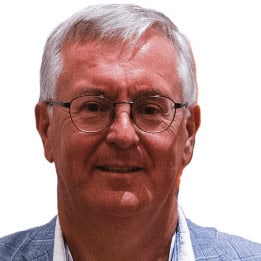
Compliance with the New Lead Restriction
Ludo Debever, General Manager, The European Plastic Pipes and Fittings Association (TEPPFA)
Abstract
On 8 May 2023, the European Commission published the Commission Regulation (EU) 2093/923 as regards the restriction on the use of lead and its compounds in PVC. On 29 November 2024, the 0.1% lead restriction will take effect.
By 2003 PVC pipe manufacturers replaced Pb based stabilisers in their PVC formulations for drinking water pipes by CaZn or Organic Based Stabilisers (OBS) as part of the VinylPlus Voluntary Commitment. By 2012 Pb based stabilisers were replaced for all remaining rigid PVC pipes. The new restriction, however, restricts also the use of and will dramatically reduce the availability of Pb-containing rigid recycled PVC for the production of new multilayer PVC sewer pipes.
The closed loop recycling obligation for rigid PVC profiles from 29 May 2026 will seriously impact the use of lead containing rigid PVC recyclates from profiles in new pipes. As such, for PVC pipe manufacturers it will be a major challenge to meet demand for recycled rigid PVC from 29 May 2026 onwards.
In the presentation, Ludo Debever, General Manager of TEPPFA, will inform about the expected impact of the new Regulation and what European and Member State projects are currently under development to increase the availability of rigid recycled PVC.

